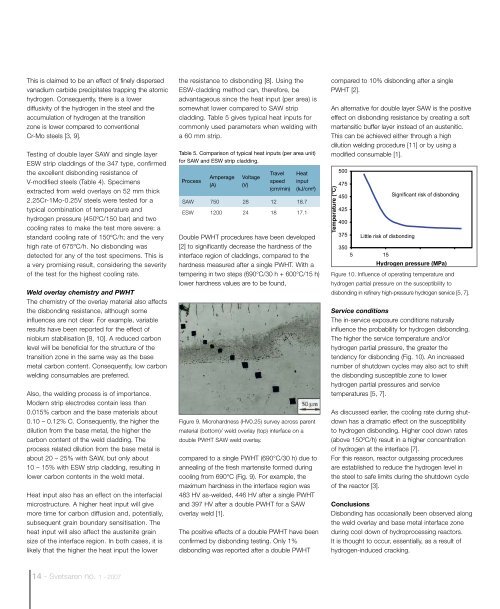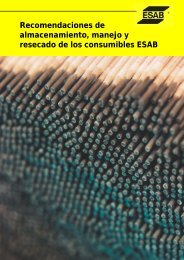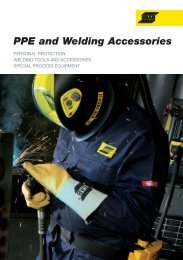You also want an ePaper? Increase the reach of your titles
YUMPU automatically turns print PDFs into web optimized ePapers that Google loves.
This is claimed to be an effect of finely dispersed<br />
vanadium carbide precipitates trapping the atomic<br />
hydrogen. Consequently, there is a lower<br />
diffusivity of the hydrogen in the steel and the<br />
accumulation of hydrogen at the transition<br />
zone is lower compared to conventional<br />
Cr-Mo steels [3, 9].<br />
Testing of double layer SAW and single layer<br />
ESW strip claddings of the 347 type, confirmed<br />
the excellent disbonding resistance of<br />
V-modified steels (Table 4). Specimens<br />
extracted from weld overlays on 52 mm thick<br />
2.25Cr-1Mo-0.25V steels were tested for a<br />
typical combination of temperature and<br />
hydrogen pressure (450ºC/150 bar) and two<br />
cooling rates to make the test more severe: a<br />
standard cooling rate of 150ºC/h; and the very<br />
high rate of 675ºC/h. No disbonding was<br />
detected for any of the test specimens. This is<br />
a very promising result, considering the severity<br />
of the test for the highest cooling rate.<br />
Weld overlay chemistry and PWHT<br />
The chemistry of the overlay material also affects<br />
the disbonding resistance, although some<br />
influences are not clear. For example, variable<br />
results have been reported for the effect of<br />
niobium stabilisation [8, 10]. A reduced carbon<br />
level will be beneficial for the structure of the<br />
transition zone in the same way as the base<br />
metal carbon content. Consequently, low carbon<br />
welding consumables are preferred.<br />
Also, the welding process is of importance.<br />
Modern strip electrodes contain less than<br />
0.015% carbon and the base materials about<br />
0.10 – 0.12% C. Consequently, the higher the<br />
dilution from the base metal, the higher the<br />
carbon content of the weld cladding. The<br />
process related dilution from the base metal is<br />
about 20 – 25% with SAW, but only about<br />
10 – 15% with ESW strip cladding, resulting in<br />
lower carbon contents in the weld metal.<br />
Heat input also has an effect on the interfacial<br />
microstructure. A higher heat input will give<br />
more time for carbon diffusion and, potentially,<br />
subsequent grain boundary sensitisation. The<br />
heat input will also affect the austenite grain<br />
size of the interface region. In both cases, it is<br />
likely that the higher the heat input the lower<br />
the resistance to disbonding [8]. Using the<br />
ESW-cladding method can, therefore, be<br />
advantageous since the heat input (per area) is<br />
somewhat lower compared to SAW strip<br />
cladding. Table 5 gives typical heat inputs for<br />
commonly used parameters when welding with<br />
a 60 mm strip.<br />
Table 5. Comparison of typical heat inputs (per area unit)<br />
for SAW and ESW strip cladding.<br />
Process<br />
Amperage<br />
(A)<br />
Voltage<br />
(V)<br />
Figure 9. Microhardness (HV0.25) survey across parent<br />
material (bottom)/ weld overlay (top) interface on a<br />
double PWHT SAW weld overlay.<br />
Travel<br />
speed<br />
(cm/min)<br />
Heat<br />
input<br />
(kJ/cm²)<br />
SAW 750 28 12 18.7<br />
ESW 1200 24 18 17.1<br />
Double PWHT procedures have been developed<br />
[2] to significantly decrease the hardness of the<br />
interface region of claddings, compared to the<br />
hardness measured after a single PWHT. With a<br />
tempering in two steps (690°C/30 h + 600°C/15 h)<br />
lower hardness values are to be found,<br />
compared to a single PWHT (690°C/30 h) due to<br />
annealing of the fresh martensite formed during<br />
cooling from 690°C (Fig. 9). For example, the<br />
maximum hardness in the interface region was<br />
483 HV as-welded, 446 HV after a single PWHT<br />
and 397 HV after a double PWHT for a SAW<br />
overlay weld [1].<br />
The positive effects of a double PWHT have been<br />
confirmed by disbonding testing. Only 1%<br />
disbonding was reported after a double PWHT<br />
compared to 10% disbonding after a single<br />
PWHT [2].<br />
An alternative for double layer SAW is the positive<br />
effect on disbonding resistance by creating a soft<br />
martensitic buffer layer instead of an austenitic.<br />
This can be achieved either through a high<br />
dilution welding procedure [11] or by using a<br />
modified consumable [1].<br />
Figure 10. Influence of operating temperature and<br />
hydrogen partial pressure on the susceptibility to<br />
disbonding in refinery high-pressure hydrogen service [5, 7].<br />
Service conditions<br />
The in-service exposure conditions naturally<br />
influence the probability for hydrogen disbonding.<br />
The higher the service temperature and/or<br />
hydrogen partial pressure, the greater the<br />
tendency for disbonding (Fig. 10). An increased<br />
number of shutdown cycles may also act to shift<br />
the disbonding susceptible zone to lower<br />
hydrogen partial pressures and service<br />
temperatures [5, 7].<br />
As discussed earlier, the cooling rate during shutdown<br />
has a dramatic effect on the susceptibility<br />
to hydrogen disbonding. Higher cool down rates<br />
(above 150ºC/h) result in a higher concentration<br />
of hydrogen at the interface [7].<br />
For this reason, reactor outgassing procedures<br />
are established to reduce the hydrogen level in<br />
the steel to safe limits during the shutdown cycle<br />
of the reactor [3].<br />
Conclusions<br />
Disbonding has occasionally been observed along<br />
the weld overlay and base metal interface zone<br />
during cool down of hydroprocessing reactors.<br />
It is thought to occur, essentially, as a result of<br />
hydrogen-induced cracking.<br />
14 - <strong>Svetsaren</strong> no. 1 - <strong>2007</strong>




